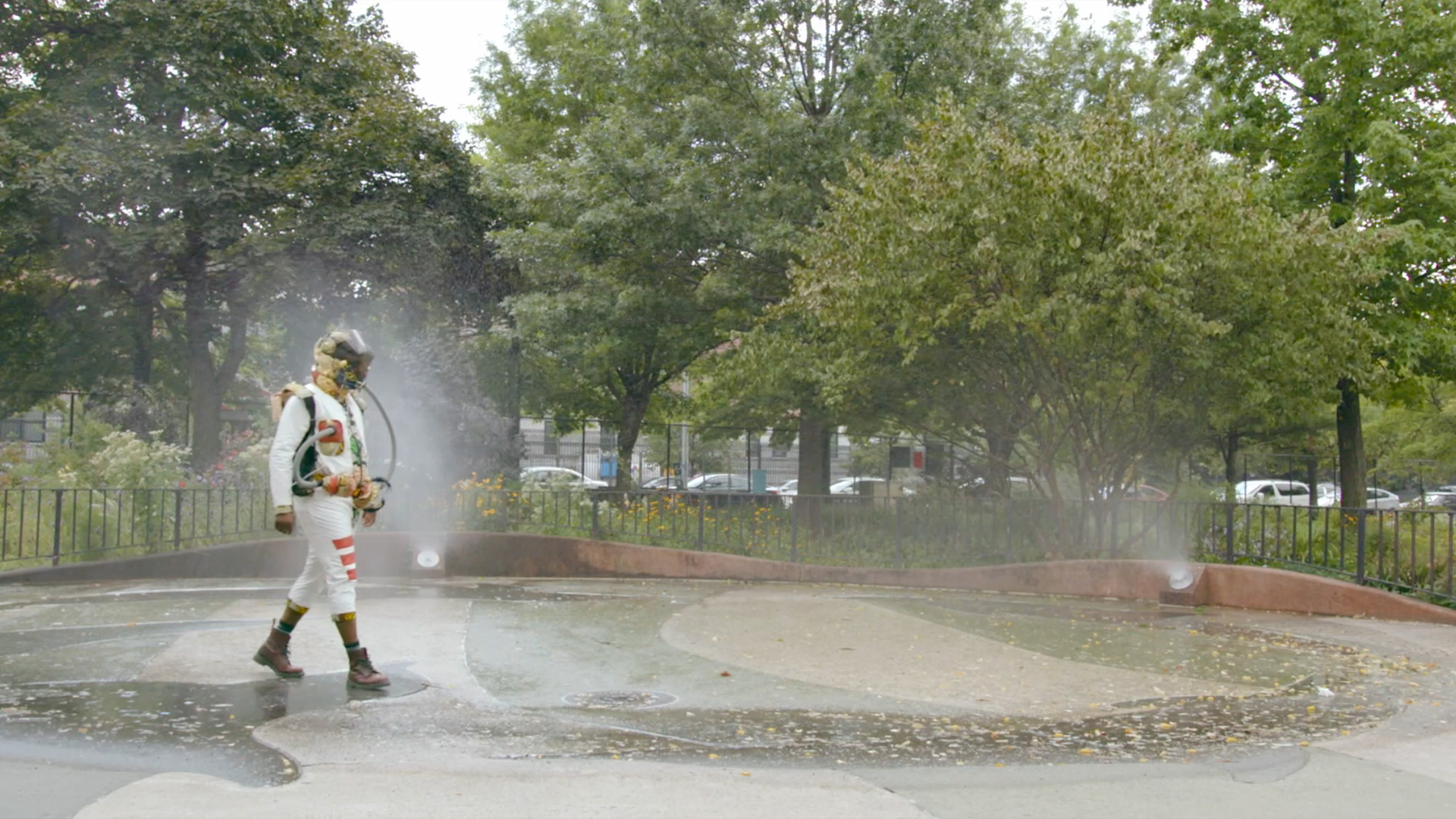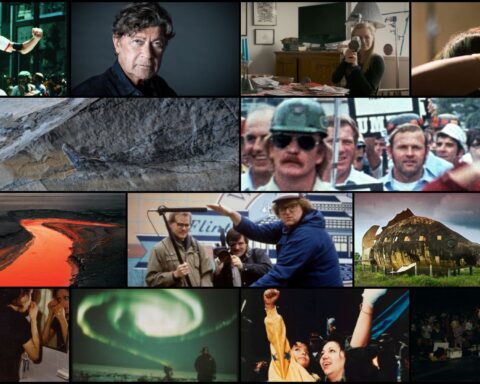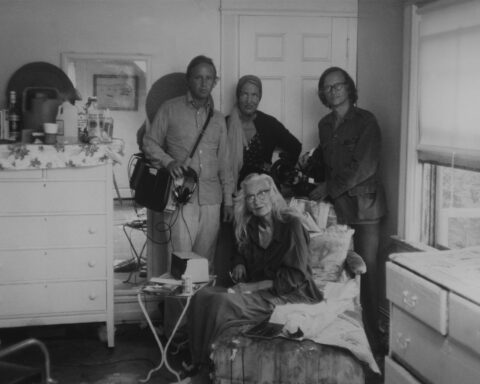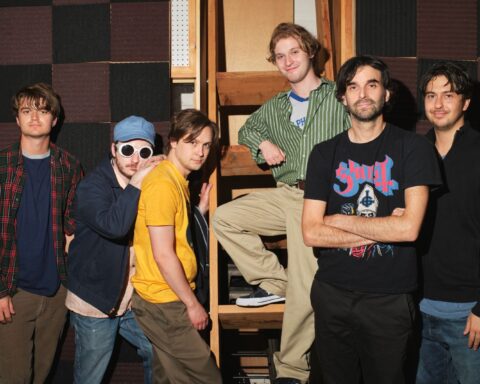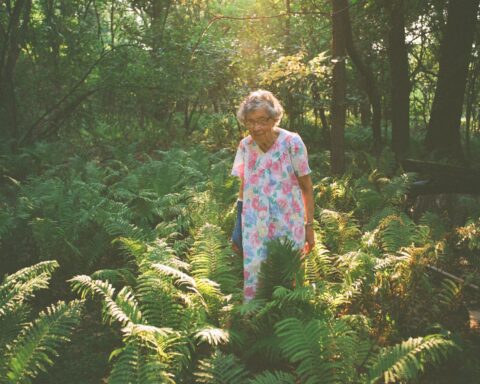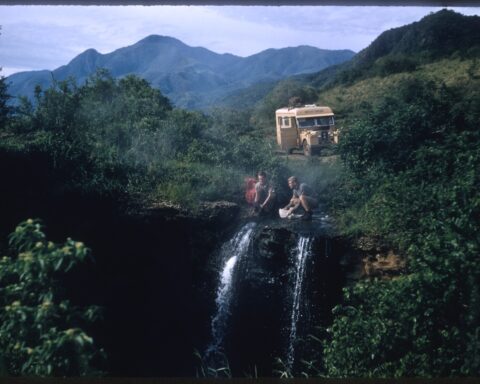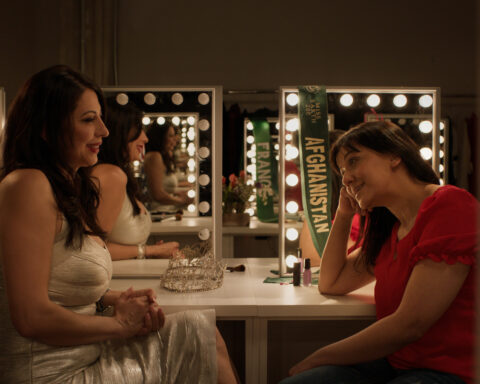The political pertinence of absence might be the most pressing issue in contemporary radical thought. Extinct species, ultra-mobile capital, drowned refugees, prisoners, historical trauma—these issues are often acknowledged but rarely or never actually seen. They speak of systems that constitute and control populations and societies, systems that are otherwise difficult or impossible to lock down, systems that are very real and very powerful and very difficult to critique and dismantle because they are invisible: neoliberalism and nationalism above all.
Here, I want to discuss a set of approaches to documentary filmmaking that take these absences seriously. M. NourbeSe Philip often says that her epic poem Zong!, about the 1781 murder of 150 African slaves on the eponymous slave ship, tells a story that cannot be told, yet must be told: no words can do justice to the atrocity, and yet nothing could be more important than trying to do so. In addressing both the story and the impossibility of its telling, Philip constructs her poem completely from the text of the court case dealing with it—the only written record that it ever happened.
In an analogous vein, the films I’m interested in here all address the question: how to film the unfilmable, which must be filmed?
The range of conventional approaches is all too familiar. A documentary about the effects of capitalism — The China Hustle (2017), for example—will largely take place in a bank, with maybe a field trip to a post-industrial wasteland to show the effects of all those big numbers and bigger egos on “the little guy.” A film about history will simply narrate the story via a combination of archival footage, staged interviews and voiceover: the Ken Burns look. A film about ecological devastation — Chasing Coral (2017) is a decent example — will feature some intrepid do-gooders in exotic locales figuring out just what the heck is going on there. And so on.
There are many worthy films in all those styles, of course. But what they miss in their conventional approaches is the most important thing: the new realities that emerge out of those absences. In reorienting from past to present, from narrativizing history to deconstructing its instrumentalization, these films are resolute in tracking the absent and invisible via the present and the visible.
Specifically, I think these filmmakers pick up on the philosopher Jacques Derrida’s idea of the trace and apply it to history and politics. In Columbia University professor Gayatri Chakravorty Spivak’s gloss, “Derrida’s trace is the mark of the absence of a presence, an always already absent present, of the lack at the origin that is the condition of thought and experience.” It’s a metaphysical—or more properly anti-metaphysical—concept, but its resonances are much broader, and this cohort of filmmakers uses it to shine a light on the absences that bespeak the violence at the origins of our social, political and economic systems, the absences that are themselves technologies of social control.
The Act of Killing (2012), Joshua Oppenheimer’s seminal documentary about the Indonesian genocide of 1965–66, is a paradigmatic example of the cinema of absence. It’s a film about history that refuses either to narrate or analyze it; a film about genocide that focuses almost exclusively, and for the most part non-judgmentally, on its perpetrators, not its victims, and a documentary in which a considerable portion is staged—and by its subjects, not its director, at that. The entire film is, in a crucial sense, performed. It eschews authoritative exposé, emotional testimony, sincere meditation—the conventions of this sort of thing, Resnais through Lanzmann to Panh and Morris, and including, of course, a host of lesser filmmakers as well—in favour of a resolute attention to the bizarre and the banal in approaching the spectre of extreme, traumatic violence and the way in which, unseen, it structures society.
Anwar Congo, foremost among the film’s subjects, brings these tensions into focus. On the one hand, Congo boasts of his murders, demonstrating them willfully for Oppenheimer’s camera, even dancing gleefully at the site of the extermination. On the other hand, he has nightmares, does drugs to forget what he’s done, and needs to rationalize his acts by recourse to the propaganda film that he and his gangster friends know full well is a lie. The film’s mix of observation and reenactments bring out these conflicts, embracing performance in all its dimensions: the performance of everyday life as well as the dramatizing, and thereby exteriorizing, of memory and imagination, to reveal things that Congo may have preferred to hide. The film’s haunting finale is an indelible image of stillborn catharsis: the past is dead, the future not ready to be born. The murders on which the society is built and the propaganda and lies that have allowed Congo and his ilk to escape punishment for them have been revealed, and yet nothing new proffers itself. For the time being, the tension remains unresolved.
Bisbee ’17 (2018) is also a film that links history and performance. Robert Greene’s previous two films, Actress (2014) and Kate Plays Christine (2016), had made his name as a documentary filmmaker attuned to the ways in which identity, far from being innate and essential, is in fact constructed and performed—often, in fact, concealing a void where the self should be. Bisbee ’17 extends these insights to the level of society. Bisbee, Arizona, a stone’s throw from the Mexican border and about 20 miles south of Tombstone, was the site of a Phelps Dodge copper mine that, in 1917, became a flashpoint in union activity when the International Workers of the World (IWW) called a strike for better working conditions and higher wages. What happened next combines the spirit of the Wild West with wartime nationalism, Red Scare politics and border-town xenophobia: the county sheriff deputized around 2000 scabs who worked at the mine and ran the 1300 or so strikers out of town on a train, abandoning them in the middle of the desert in New Mexico.
Like The Act of Killing, Bisbee ’17 is not really about the past, but about the past’s manifold resonances in the present. But here, the re-enactors aren’t the perpetrators. In some cases, they are their descendants; in other cases, they are town residents; in yet other cases, they are actors from nearby Tombstone. Greene is particularly interested in a young, gay Mexican-American, who experiences a political awakening over the course of the film. By the end of the film, we have an image starkly opposed to that of The Act of Killing — a vision of community that has somehow transcended its dark history. Whether it is quite convincing is immaterial; the intervention is the point. And perhaps intervention is always the point.
BISBEE ‘17 (Theatrical Trailer) from prewarcinema on Vimeo.
Josua Bonnetta and J.P. Sniadecki’s El mar la mar (2017) is the most direct of the films discussed here in structuring itself around Derrida’s idea of the trace. Though the filmmakers are affiliated with the Sensory Ethnography Lab, El mar la mar was produced independently of it, which seems proper: though it’s immersive, in a way, it’s also suspicious of surfaces, always attuned to the stories and histories of which surfaces are mere traces. It doesn’t feel quite right to say El mar la mar is about migrants. We never see any, after all. Nor does it feel right to say it’s about the Sonora desert. That’s too broad. Maybe it’s closer to say it’s about the wages of migration in the abstract. Or about migration’s detritus. The film is all about discovering the traces of migrants from Mexico on the American side of the Sonora desert—jettisoned backpacks, fire pits, etc.—and juxtaposing these haunting images with voiceover narration, usually spoken by migrants, talking about their harrowing journeys across the border.
In leaving the migrants invisible and anonymous, El mar la mar confirms once again that necessity is the mother of invention: they, and the landscape itself, take on a mythical dimension that their more direct presence, which would have been legally problematic, might not have allowed. It’s this mythical dimension that takes the film from liberal polemic to radical poetic reflection on the figures of the migrant, the border and the desert in the American psyche, and the reality of the harsh, profoundly indifferent nature underlying those symbols.
In its evocation of the spectre of nature beyond society and politics, El mar la mar has much in common with Canadian filmmaker Brett Story’s new film, The Hottest August. Her first feature, 2016’s The Prison in Twelve Landscapes, was an exemplary study of the wide-ranging effects of mass incarceration on the US, discovering traces in some of the most iconic images in 21st-century America, from the chess players of Washington Square Park, one of whom is an ex-con, to a blue-collar warehouse worker whose brother is in prison, to a part of Detroit gentrifying on the back of aggressive policing, to the California wildfires being fought by prisoners. In The Hottest August, Story sticks to New York City, making our looming environmental catastrophe (the first of many hot summers) and a constrained timeline (the month of August) the background to a cross-section of society, much as Chris Marker used the Algerian War and the month of May in Le joli mai (1963).
Story’s go-to question for all her interviewees—always interrogated on-site around New York, whether it be on the beach, in an art studio or office, outside a garage, or in a swamp on the outskirts of the city—is about the future. Responses are suitably varied and touch on a range of personal, social and political anxieties. Two ex-cops in a Staten Island bar recall their days on the Bed-Stuy beat, pre-gentrification, remarking that someone like Story, a Brooklyn resident at the time, would never have lived there back then. A couple in the Bronx worry about the rise in crime—real or perceived—in the neighbourhood they’ve lived in for decades. A woman describes putting herself through college while working full-time at a call centre. Two old union men bemoan the undercutting of unions by undocumented immigrants, who are exploited by employers and then send much of their earnings back home. And so on.
These interviews, which organically draw attention to all sorts of hidden structures and fissures in society, are interspersed with two other threads: first, an enigmatic voiceover narration, largely drawn from texts by Karl Marx, Zadie Smith and Annie Dillard and voiced by Canadian theatre actress Clare Coulter in the mannered tones of a Laurie Anderson or Alexandra Stewart work; second, occasional observational interludes, often accompanied by a droning soundtrack, that recall the classic silent-era city symphonies. These offer wry reflections on the contemporary situation. For example, from Smith: “People in mourning tend to use euphemism. The most melancholy of all the euphemisms: the new normal.”
Voiceover is unusual in the cinema of absence, but in using it to thread important writers’ articulations of the zeitgeist into the fabric of the film, The Hottest August points a way forward for this kind of documentary, away from the miserabilism or nihilism that it can easily fall into, towards a fuller and more thorough, multi-dimensional speculative mode. Bolstering this impression is an episode towards the end of the film in which we follow a man in a homemade space suit around New York, waving to and chatting with neighbours. He explains that he’s an African-American astronaut sent from the future to report on the present. These techniques illustrate the political urgency that is a surprising but defining hallmark of the cinema of absence, which emerges not in the mode of activism but of fulsome and imaginative consideration, a kaleidoscopic and visionary corrective to the hot-take mentality.
At the other end of the spectrum from The Hottest August’s complicated optimism is much of the recent documentary work by Ukrainian director Sergei Loznitsa. Very unusually, he works in three distinct veins: observational documentary, archival assemblage and drama. His archival assemblage is almost the exact opposite of the kind of thing I’m describing—his recent films The Event (2015) and The Trial (2018) are eerie feel-like-you’re-there reconstructions of historical events—while his dramas aim for the kind of Brechtian blend of absurdity and realism familiar from the films of Roy Andersson, and can feel slightly academic. Loznitsa’s observational documentaries, though, are outstanding, and Austerlitz (2016) is a particularly poignant, and troubling, example of the genre I’m talking about.
In a series of austere black-and-white compositions and an immersive soundscape, Austerlitz constructs a day at a concentration camp—that is, the present-day camp-as-museum, full of bored tourists, dispassionate guides, and mute walls. (Material was shot at Dachau and Sachsenhausen.) From this minimalist conceit emerges a densely layered sensory experience and a deeply disquieting critique of Holocaust commemoration: an immersion in the absence of meaning, a nihilistic totem to the impossibility of understanding. Late in the film, after we witness streams of tourists from all over the globe treat these sites of horror in a shockingly blasé manner, even taking selfies in front of the “arbeit macht frei” sign, a guide remarks that the site contains frustratingly little evidence of the atrocities committed there. This trope has a long history in Holocaust cinema. In Alain Resnais’ Night and Fog (1955), one of the earliest films about the Holocaust, the narrator is preoccupied with how little, ten years after the fact, the concentration camp reveals about what happened there: “No description, no shot can restore their true dimension: Endless, uninterrupted fear.” Loznitsa’s innovation is to link that unknowability with contemporary performative rituals of commemoration.
Much Holocaust cinema is understandably preoccupied with memory: how to overcome the temporal distance between then and now to represent crimes of such magnitude. Films like Schindler’s List (1993) and Life is Beautiful (1997), among (too) many others, have tried to overcome the distance by adopting narrative strategies of sympathy and immersion. Others, among them Night and Fog and Shoah (1985), have grappled more directly with the fundamental issue of how to represent loss and absence. All of these films have, to one extent or another, positioned themselves as humanist totems— affective gateways into the experience of the Holocaust. The point being that this is how we will ensure it never happens again.
Austerlitz turns this idea on its head. It neither transcends the temporal distance between now and then, nor dwells on how it might be done. Instead, like W.G. Sebald’s identically titled novel, it lingers on absence. Its sublimation of observation and critique into a shallow, hollow, meaningless immersion turns it, finally, into a sort of anti-totem: a ritual reminder that we have learned nothing. Depressingly, it’s the most compelling Holocaust film I’ve seen.
Earlier, I suggested that the films of the cinema of absence could be thought of as interventions. By this, I think I mean: films that supersede the classical problems and structures of documentary filmmaking (representation, responsibility, etc.) by way of aesthetic strategies that both ground the films rigorously in their subjects—often in direct collaboration with them—and at the same time point beyond them in multiple directions, ultimately come to a more honest—a radically honest, I would say—interpretation of events. These films — The Act of Killing, Bisbee ’17, El mar la mar, The Hottest August and Austerlitz — attune themselves to abstract links between past, present and future, between base and superstructure, between systems and ideologies and the muddled realities of human lives in which they are played out and performed.
It’s that multidimensional, yet integrated and coherent, aesthetic philosophy that makes me want to single them out and group them together, despite their differences. Ultimately, what I mostly want to do is celebrate them. For a host of familiar reasons, I think that documentary film, as “creative treatment of actuality,” has a lot to offer in terms of thinking through the absurdities of the world today. These are the ones I turn to.




